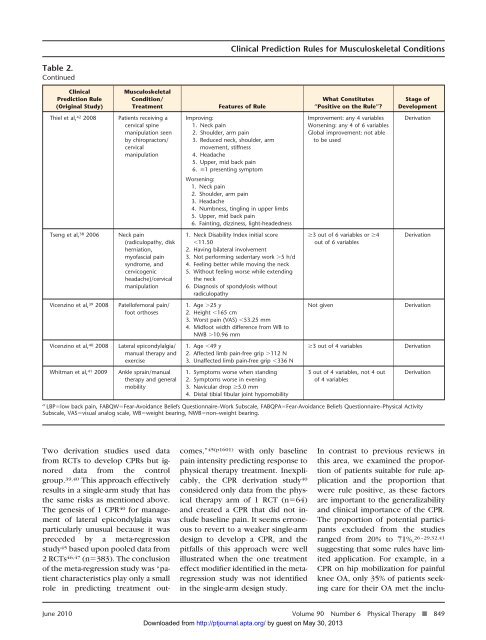Critical Appraisal of Clinical Prediction Rules That Aim to Optimize ...
Critical Appraisal of Clinical Prediction Rules That Aim to Optimize ...
Critical Appraisal of Clinical Prediction Rules That Aim to Optimize ...
You also want an ePaper? Increase the reach of your titles
YUMPU automatically turns print PDFs into web optimized ePapers that Google loves.
Table 2.<br />
Continued<br />
<strong>Clinical</strong><br />
<strong>Prediction</strong> Rule<br />
(Original Study)<br />
Thiel et al, 42 2008 Patients receiving a<br />
cervical spine<br />
manipulation seen<br />
by chiroprac<strong>to</strong>rs/<br />
cervical<br />
manipulation<br />
Tseng et al, 38 2006 Neck pain<br />
(radiculopathy, disk<br />
herniation,<br />
my<strong>of</strong>ascial pain<br />
syndrome, and<br />
cervicogenic<br />
headache)/cervical<br />
manipulation<br />
Vicenzino et al, 39 2008 Patell<strong>of</strong>emoral pain/<br />
foot orthoses<br />
Vicenzino et al, 40 2008 Lateral epicondylalgia/<br />
manual therapy and<br />
exercise<br />
Whitman et al, 41 2009 Ankle sprain/manual<br />
therapy and general<br />
mobility<br />
Two derivation studies used data<br />
from RCTs <strong>to</strong> develop CPRs but ignored<br />
data from the control<br />
group. 39,40 This approach effectively<br />
results in a single-arm study that has<br />
the same risks as mentioned above.<br />
The genesis <strong>of</strong> 1 CPR 40 for management<br />
<strong>of</strong> lateral epicondylalgia was<br />
particularly unusual because it was<br />
preceded by a meta-regression<br />
study 45 based upon pooled data from<br />
2 RCTs 46,47 (n383). The conclusion<br />
<strong>of</strong> the meta-regression study was “patient<br />
characteristics play only a small<br />
role in predicting treatment out-<br />
Musculoskeletal<br />
Condition/<br />
Treatment Features <strong>of</strong> Rule<br />
<strong>Clinical</strong> <strong>Prediction</strong> <strong>Rules</strong> for Musculoskeletal Conditions<br />
Improving:<br />
1. Neck pain<br />
2. Shoulder, arm pain<br />
3. Reduced neck, shoulder, arm<br />
movement, stiffness<br />
4. Headache<br />
5. Upper, mid back pain<br />
6. 1 presenting symp<strong>to</strong>m<br />
Worsening:<br />
1. Neck pain<br />
2. Shoulder, arm pain<br />
3. Headache<br />
4. Numbness, tingling in upper limbs<br />
5. Upper, mid back pain<br />
6. Fainting, dizziness, light-headedness<br />
1. Neck Disability Index initial score<br />
11.50<br />
2. Having bilateral involvement<br />
3. Not performing sedentary work 5 h/d<br />
4. Feeling better while moving the neck<br />
5. Without feeling worse while extending<br />
the neck<br />
6. Diagnosis <strong>of</strong> spondylosis without<br />
radiculopathy<br />
1. Age 25 y<br />
2. Height 165 cm<br />
3. Worst pain (VAS) 53.25 mm<br />
4. Midfoot width difference from WB <strong>to</strong><br />
NWB 10.96 mm<br />
1. Age 49 y<br />
2. Affected limb pain-free grip 112 N<br />
3. Unaffected limb pain-free grip 336 N<br />
1. Symp<strong>to</strong>ms worse when standing<br />
2. Symp<strong>to</strong>ms worse in evening<br />
3. Navicular drop 5.0 mm<br />
4. Distal tibial fibular joint hypomobility<br />
comes,” 45(p1601) with only baseline<br />
pain intensity predicting response <strong>to</strong><br />
physical therapy treatment. Inexplicably,<br />
the CPR derivation study 40<br />
considered only data from the physical<br />
therapy arm <strong>of</strong> 1 RCT (n64)<br />
and created a CPR that did not include<br />
baseline pain. It seems erroneous<br />
<strong>to</strong> revert <strong>to</strong> a weaker single-arm<br />
design <strong>to</strong> develop a CPR, and the<br />
pitfalls <strong>of</strong> this approach were well<br />
illustrated when the one treatment<br />
effect modifier identified in the metaregression<br />
study was not identified<br />
in the single-arm design study.<br />
What Constitutes<br />
“Positive on the Rule”?<br />
Improvement: any 4 variables<br />
Worsening: any 4 <strong>of</strong> 6 variables<br />
Global improvement: not able<br />
<strong>to</strong> be used<br />
3 out <strong>of</strong> 6 variables or 4<br />
out <strong>of</strong> 6 variables<br />
Stage <strong>of</strong><br />
Development<br />
Derivation<br />
Derivation<br />
Not given Derivation<br />
3 out <strong>of</strong> 4 variables Derivation<br />
3 out <strong>of</strong> 4 variables, not 4 out<br />
<strong>of</strong> 4 variables<br />
a LBPlow back pain, FABQWFear-Avoidance Beliefs Questionnaire–Work Subscale, FABQPAFear-Avoidance Beliefs Questionnaire–Physical Activity<br />
Subscale, VASvisual analog scale, WBweight bearing, NWBnon–weight bearing.<br />
Derivation<br />
In contrast <strong>to</strong> previous reviews in<br />
this area, we examined the proportion<br />
<strong>of</strong> patients suitable for rule application<br />
and the proportion that<br />
were rule positive, as these fac<strong>to</strong>rs<br />
are important <strong>to</strong> the generalizability<br />
and clinical importance <strong>of</strong> the CPR.<br />
The proportion <strong>of</strong> potential participants<br />
excluded from the studies<br />
ranged from 20% <strong>to</strong> 71%, 26–29,32,41<br />
suggesting that some rules have limited<br />
application. For example, in a<br />
CPR on hip mobilization for painful<br />
knee OA, only 35% <strong>of</strong> patients seeking<br />
care for their OA met the inclu-<br />
June 2010 Volume 90 Number 6 Physical Therapy f 849<br />
Downloaded from<br />
http://ptjournal.apta.org/ by guest on May 30, 2013
















